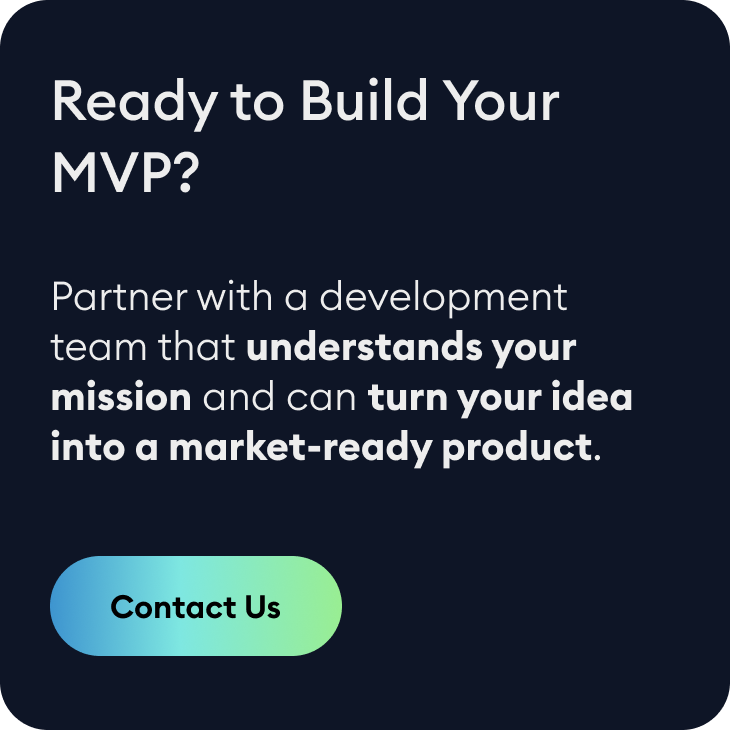Did you know that 50 million startups are launched every year? That's about 137,000 startups emerging daily, according to a 2022 Microsoft report. With so much competition, standing out in the startup ecosystem isn't just about having a brilliant idea—it's about executing it efficiently.
For startups, where the stakes are high, and the clock is ticking on global sustainability goals, building a Minimum Viable Product (MVP) can be your golden ticket. An MVP isn't just a tech buzzword; it's a strategy to validate your vision, conserve resources, and create a product that truly resonates with your target audience.
This guide will walk you through why MVPs matter, how to build one, and how it can set your startup on a path to success.
Key Takeaways
- Why MVP development is crucial for startups.
- Steps to design an MVP that attracts users and investors.
- Common pitfalls to avoid during MVP development.
Why MVPs Matter
Startups have a dual challenge: solving global problems while competing in a crowded marketplace. This makes MVP development not just important but essential. Here's why:
- Validate Market Fit Quickly: Before committing to full-scale development, an MVP allows you to test if your product resonates with your target market.
- Optimize Resource Use: Startups that burn through cash on unnecessary features often fail to deliver real value. An MVP ensures you're spending wisely.
- Gain Early Momentum: An MVP can attract early adopters, giving you valuable feedback and helping you build traction that excites investors.
And speaking of standing out, consider this: with so many startups entering the fray daily, how many do you think have an MVP strategy? The ones that do are already a step ahead.
Steps to Building a Winning MVP
Start with the Core Problem
Your MVP should solve a specific, pressing problem for your target audience. Ask yourself: What's the one thing my product must do to add value?
Prioritize Features Like a Pro
Don't fall into the trap of "feature bloat." Instead, use prioritization frameworks like MoSCoW (Must-have, Should-have, Could-have, Won't-have) to keep your MVP lean and impactful. Remember, you're building a viable product, not a perfect one.
Build Fast, Iterate Faster
Collaborate with a development team that understands agile methodologies. The goal is to get a functional product into users' hands quickly. Feedback loops are your best friend here—embrace them.
Test, Test, Test
Launch your MVP to a select group of users, whether they're early adopters or beta testers. Gather insights, analyze data, and refine your product. The key here is listening to what your users need—not what you think they need.
MVPs: The Secret Sauce for Startup Success
So, why does the MVP approach work so well? For starters:
- Saves Resources: With an MVP, you're focusing only on essentials. This means lower development costs and less time to market—two critical factors for startups with limited resources.
- Validates Ideas: An MVP lets you test your assumptions before you've invested heavily. Think of it as your startup's reality check.
- Builds Investor Confidence: Investors love data. An MVP gives you a tangible product and real user insights to share, making your pitch far more compelling.
Common MVP Pitfalls to Avoid
Building an MVP is as much about what you don't do as what you do. Watch out for these common traps:- Overloading Features: Don't try to do it all in one go. A feature-packed product isn't always a better product.
- Ignoring Feedback: The whole point of an MVP is to learn. If you're not listening to your users, you're missing the mark.
- Skipping Iterations: The first version is just the beginning. Keep refining until you've nailed what your audience wants.
Conclusion
Building an MVP isn't just a step in your product development journey—it's a strategic move to ensure your startup is solving the right problems for the right people. In a world where 137,000 startups launch daily, having a validated, user-approved product can set you apart from the crowd.
Are you ready to turn your vision into a tangible, impactful solution? Let's build your MVP together and make a difference.
FAQ
What's the difference between an MVP and a prototype?
A prototype is a preliminary model used to visualize an idea, whereas an MVP is a working product designed to test your concept with real users.
How much time does it take to build an MVP?
Depending on complexity, an MVP can take anywhere from 3 to 6 months to develop.
Can an MVP help in securing additional funding?
Absolutely. A well-executed MVP demonstrates traction and validates your idea, which can be a powerful tool for attracting investors.


